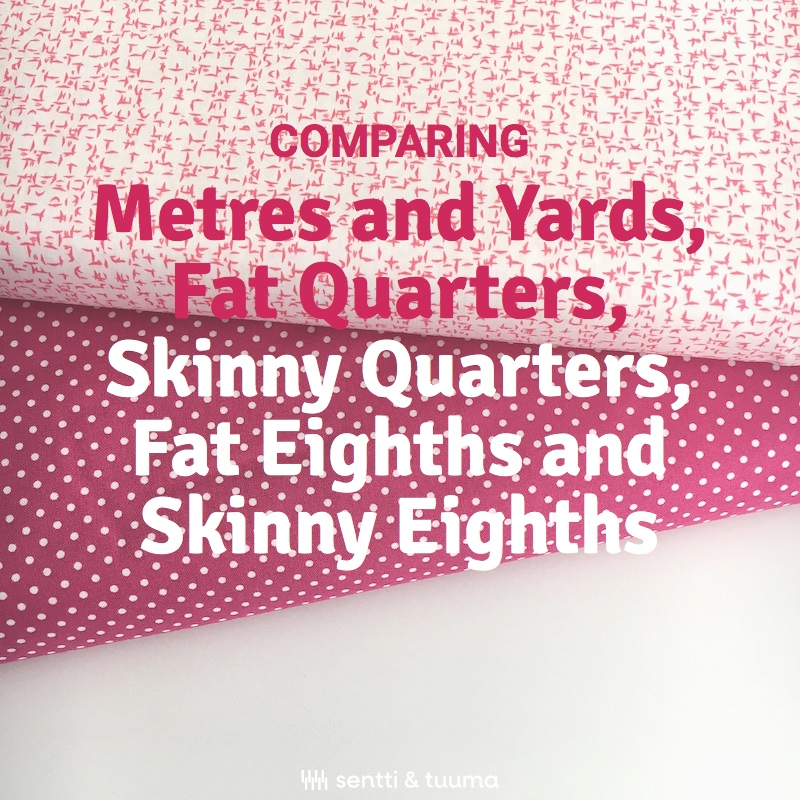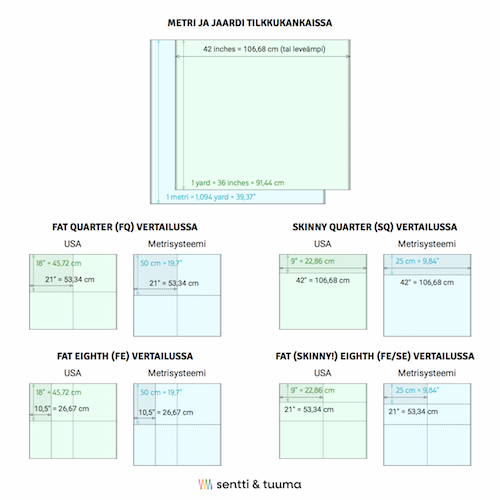It may seem simple at first to sort the differences between metres and yards in quilting fabrics, but add fat and skinny quarters as well as fat and skinny eighths, and measurements aren’t as clear anymore. We untie knots of the brain here.

Before we begin defining the words, scroll down for an infographic you may download for your personal use.
Metre versus Yard
If you buy fabric in the USA and a few other countries, the measuring system is yard. One yard (1 y) equals 36 inches (36″).
In Europe we sell fabric by the metre, which is an international measuring system, also the standard in science. One metre (1 m) equals 100 centimetre (cm).
Comparing metres and yards: 1 y = 91,44 cm (0,9144 m) or 1 m = 1,094 y = 39,37″.
Skinny Quarters
A Skinny Quarter (SQ) isn’t a specific length in itself (absolute), but it’s a relative unit. We relate it to the yard and the metre.
A quarter metre is 25 % or a fourth of the length of a whole metre: 0,25 x 1 m = 25 cm.
A quarter yard is 25 % or a fourth of the length of a whole yard: 0,25 x 36″ = 9″.
When you buy fabric in a country where the metric system is used, we cut a 25-cm strip from one edge (selvedge) to the other of a fabric. You get a Skinny Quarter. This measures 9,84″.
When you buy fabric in a country where yards are used, they cut a 9-inch strip from one edge (selvedge) to the other of a fabric. You get a Skinny Quarter. This measures 22,86 cm.
The amount of fabric you get depends on the width of fabric used by each manufacturer. Quilting cotton is typically 42″-45″ or 106,68-114,3 cm wide.
Fat Quarters
Just like Skinny Quarters, the Fat Quarter (FQ) is a relative unit. We relate it to the yard and the metre.
A quarter metre is 25 % or a fourth of the surface area of a whole metre.
A quarter yard is 25 % or a fourth of the surface area of a whole yard.
When you buy fabric in a country where the metric system is used, we cut a 50-cm piece from one edge (selvedge) to the other of a fabric, horizontally. This is then cut in half vertically. The Fat Quarter you receive measures 50 cm x (half the width of fabric), or 19,7″ x (half the width of fabric).
When you buy fabric in a country where yards are used, they cut a 18-inch piece from one edge (selvedge) to the other of a fabric, horizontally. This is then cut in half vertically. The Fat Quarter you receive measures 18″ x (half the width of fabric), or 45,72 cm x (half the width of fabric).
Half the width of fabric is typically 21″-22,5″, or 53,34-57,15 cm.
Skinny Eighths and Fat Eighths
Did you know Fat Eighths sold by many fabric manufacturers as precuts are actually Skinny Eighths?
A Fat Eighth (FE) is half a FQ, an eighth (or 12,5 %) of the surface area of a yard or metre.
A Skinny Eighth (SE) is half a SQ, an eighth (or 12,5 %) of the surface area of a yard or metre.
The reason why precuts created in factories are Skinny rather than Fat is unconfirmed.
- My uneducated guess, however, is that to achieve a real FE, for each half-yard or -metre you would create two pieces from the middle with no selvedge on any side (see infographic below). Maybe it’s too rough with four raw edges? The machine would also have to separate four Fat-Eighth pieces.
- To achieve a SE the machine cuts 9″ across the fabric and then probably shaves off a tiny strip from the non-selvedge edge in the middle, where fabric has been doubled. Now the machine (or a person) has to separate only two pieces.
Again the final size of the Fat Eighth depends on: 1) where in the world you buy the piece, 2) how the shop chooses to cut (”real” Fat Eighth, or ”fake” Fat Eighth aka the Skinny Eighth), and 3) the width of fabric chosen by the manufacturer.
Our Infographics
Please click on the version below, which you can download in full size for your personal use!
English:
Suomi:
Svenska:
Hope you found this useful. Ask questions in the comments below if there’s anything at all you’re still wondering about!



Vastaa
Sinun täytyy kirjautua sisään kommentoidaksesi.